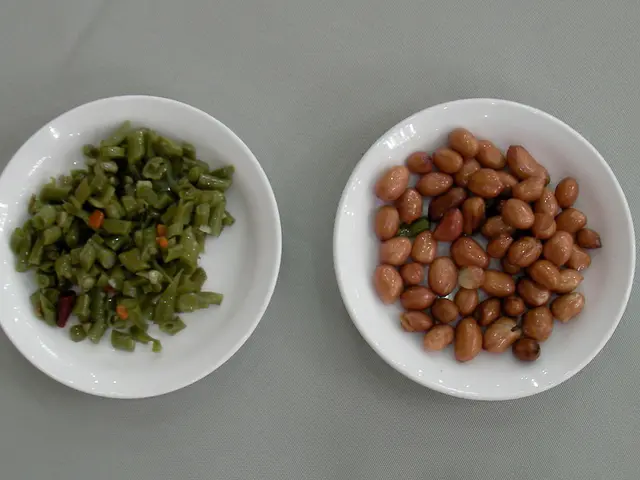Avert a potential brain aneurysm rupture
Brain aneurysms, weak and bulging areas in the walls of brain arteries, can be potentially life-threatening. While the exact causes of brain aneurysms are not fully understood, several modifiable risk factors have been identified that can increase the risk of their formation and rupture.
Smoking is a major risk factor for both the formation and rupture of brain aneurysms. Smoking damages blood vessel walls and promotes hypertension, a key risk factor for brain aneurysms [1][3][5]. Former smokers also have a significantly higher risk than those who have never smoked.
High blood pressure (hypertension) weakens vessel walls over time, increasing the risk of aneurysm development and rupture [1][3][5]. Strict blood pressure control is crucial in managing brain aneurysms, as it may improve the outlook.
Diet plays an important role in aneurysm risk indirectly by influencing blood pressure, cholesterol levels, and overall vascular health. Diets rich in fruits, vegetables, nuts, and fish (such as the Mediterranean or DASH diet) help reduce hypertension and improve cardiovascular health, potentially lowering aneurysm risk. Conversely, poor diet can contribute to hypertension and vascular damage [4].
Antioxidants, found abundantly in fruits and vegetables, help reduce oxidative stress and inflammation in blood vessels, which may support vessel integrity and reduce aneurysm risk, although direct evidence specifically linking antioxidants with brain aneurysm risk is limited. Nevertheless, antioxidants contribute to cardiovascular health broadly [4].
Weight management is also recommended for reducing the risk of brain aneurysms. Maintaining a healthy weight helps control blood pressure and reduces cardiovascular strain, lowering the risk of hypertension, a key risk factor for brain aneurysms [1][4].
By controlling modifiable lifestyle factors such as smoking cessation, blood pressure management, healthy eating rich in antioxidants, and maintaining a healthy weight, individuals can decrease the risk of developing a brain aneurysm by preserving vascular integrity and reducing hypertension and other cardiovascular risks [1][3][4][5].
Treatment for a brain aneurysm depends on factors such as its size and whether it has ruptured. Small unruptured aneurysms may not require treatment, while larger or ruptured aneurysms may require surgery or endovascular coiling [6].
For those at high risk of brain aneurysm formation and rupture, it's essential to get adequate amounts of antioxidant vitamins in their diets, including vitamin C, B vitamins, vitamin E, carotenoids, flavonoids, and omega-3 fatty acids. Foods plentiful in these nutrients include whole grains, vegetables, fruit, nuts, beans, and fish [7].
Approximately 6.7 million people in the United States currently have an unruptured brain aneurysm [8]. Nearly half of those with a ruptured brain aneurysm die within 24 hours, and 50% die within 3 months [9]. Ruptured brain aneurysms account for 3-5% of all new strokes [10].
Managing high blood pressure, reducing inflammation, decreasing alcohol consumption, quitting smoking, avoiding the use of recreational drugs, managing diabetes, and managing high cholesterol can help reduce the risk of brain aneurysms [11]. Medications and appropriate lifestyle practices can help control blood pressure [12].
Various factors may lead to the formation of a brain aneurysm, including inflammation and stress on the brain arteries due to turbulent blood flow. These factors may involve the above modifiable risk factors as well as unmodifiable risk factors like age, genetics, tumors, trauma, infections such as endocarditis, and moving blood clots [13].
[1] Mayo Clinic. (2021). Brain aneurysm. Retrieved from https://www.mayoclinic.org/diseases-conditions/brain-aneurysm/symptoms-causes/syc-20374631
[2] National Institute of Neurological Disorders and Stroke. (2021). Brain aneurysm. Retrieved from https://www.ninds.nih.gov/Disorders/All-Disorders/Brain-Aneurysm-Information-Page
[3] American Heart Association. (2021). Brain aneurysm. Retrieved from https://www.heart.org/en/health-topics/stroke/understanding-stroke/brain-aneurysm
[4] American Stroke Association. (2021). Brain aneurysm. Retrieved from https://www.strokeassociation.org/en/patients/life-after-stroke/brain-aneurysm
[5] American Society of Neurorehabilitation. (2021). Brain aneurysm. Retrieved from https://www.asnr.org/Patients/Brain-Aneurysm
[6] Johns Hopkins Medicine. (2021). Brain aneurysm. Retrieved from https://www.hopkinsmedicine.org/health/conditions-and-diseases/brain-aneurysm
[7] American Heart Association. (2021). Diet and lifestyle. Retrieved from https://www.heart.org/en/healthy-living/healthy-eating/eat-smart/nutrition-basics/antioxidants
[8] American Stroke Association. (2021). Unruptured brain aneurysms. Retrieved from https://www.strokeassociation.org/en/patients/life-after-stroke/brain-aneurysm/unruptured-brain-aneurysms
[9] American Stroke Association. (2021). Brain aneurysm symptoms and causes. Retrieved from https://www.strokeassociation.org/en/patients/life-after-stroke/brain-aneurysm/brain-aneurysm-symptoms-and-causes
[10] American Heart Association. (2021). Stroke by the numbers. Retrieved from https://www.heart.org/en/health-topics/stroke/stroke-by-the-numbers
[11] American Stroke Association. (2021). Brain aneurysm risk factors. Retrieved from https://www.strokeassociation.org/en/patients/life-after-stroke/brain-aneurysm/brain-aneurysm-risk-factors
[12] American Heart Association. (2021). Blood pressure control. Retrieved from https://www.heart.org/en/health-topics/high-blood-pressure/understanding-blood-pressure-readings/blood-pressure-control
[13] American Stroke Association. (2021). Brain aneurysm causes and risk factors. Retrieved from https://www.strokeassociation.org/en/patients/life-after-stroke/brain-aneurysm/brain-aneurysm-causes-and-risk-factors
- Engaging in regular fitness-and-exercise and maintaining mental-health through stress management could help moderate other risk factors such as hypertension, given their role in weight management and overall health-and-wellness.
- Nutritionists often recommend diets low in saturated fats, trans fats, and salt, and high in whole grains, fish, fruits, and vegetables, as they promote cardiovascular-health, reduce hypertension, and support overall vascular-health, potentially lowering aneurysm risk.
- Certain mental-health conditions, such as chronic-stress and anxiety, may contribute to increased hypertension, inflammation, and poor nutrition, which could indirectly increase the risk of brain aneurysms.
- Modifying lifestyle habits for an overall healthy lifestyle can help minimize the risk of developing chronic-diseases that may contribute to brain aneurysm formation and rupture, such as high blood pressure, hypertension, and unhealthy cholesterol levels.






